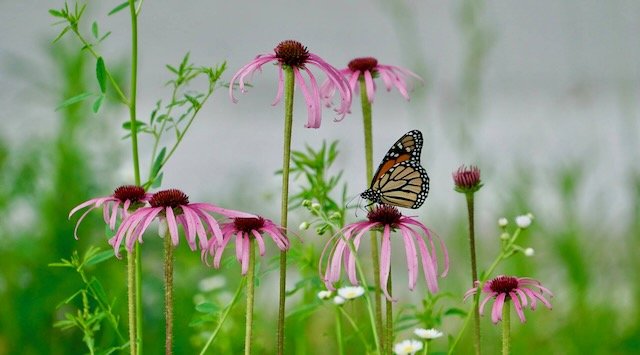Webworms have invaded us! Everywhere we look, they are there. As we drive down the road, they envelop the limbs of the trees that line the roadways. They invade the trees that inhabit our yards. In the morning and evening light, they look like a veil covering the trees. They seem to have landed like an alien invasion.
Webworms have always irritated me. I’ve wondered what damage they were doing to the trees and shrubs that I love. After a discussion at a recent Master Naturalist meeting, I was asked to do an article for our website to share some of the thoughts we discussed. So, I began my research.
Jeff Cantrell, our awesome Chert Glades advisor, assures us that the webworms do not normally cause lasting damage. They come and they go, but the trees will survive. It was hard for me to believe this because I was watching them consume large areas on the trees that I loved. But, trusting Jeff, I tried to relax and not worry that they would cause irreparable harm.
Jeff’s assurances were confirmed in my research. I learned that webworms, technically Fall Webworms, Hyphantria cunea, are native insects and do not usually cause irreparable damage because they attack the foliage later in the growth cycle, after the energy has been stored. Different trees are usually targets from year to year and therefore the trees are able to recover. If a tree is attacked year after year, recovery is more difficult. The Fall Webworm attacks over 100 species of deciduous trees and shrubs. It builds its web on the ends of branches. The larvae will feed on the leaves of the tree for about 6 weeks, continually enlarging the web. If you ever look closely at the web, you will see a mass of writhing caterpillars. It looks repulsive. They are feeding voraciously and look like something a horror movie could use to terrorize its audience. At this point in the cycle, the “worms” (caterpillars) have turned into moths and left the webs. What is left is the web and the withered remains of brown leaves and stems. Although I am bothered when I see the damage caused by the webworms during this season, knowing that it is temporary is helpful. It also helps to remember that it is all a part of the circle of life.
The Fall Webworm is sometimes confused with the Tent Caterpillar, Malacosoma, spp. It attacks the tree by building its web in the crotches of the tree and because it attacks earlier in the season, it can cause more irreparable damage. Both the Fall Webworm and the Tent Caterpillar cause unsightly defoliation. The webs may last into the winter when weather eventually causes it to fall away.
Both species have natural predators, such as birds, small mammals, spiders and other insects, etc. Some people who are annoyed with the webs and defoliation of trees on their property will tear open the web with a stick and let the birds have a feast.
I used to think that I had to cut off the infected branch and soak it in gasoline (yes, horror!) or burn it in a burn pile. This would sometimes leave my tree uneven or having large gaps. Some people will want to spray with chemicals, but it is important to understand that those chemicals may also kill the birds that are feeding on the insects. It would be better to just be patient and know that they will soon be gone. Now that I know the damage is not normally permanent, I will relax.
This year has been a banner year for the webworm. All the factors necessary for them to thrive must have been right because there seem to have been more than I’ve ever remembered.
I still do not like the looks of those nasty caterpillars eating away at my beautiful trees, but I can learn to live with them. I will remind myself that they will soon be gone. As with all things, a little knowledge goes a long way towards understanding.
Photos by Katharine Spigarelli and Kevin Mouser




